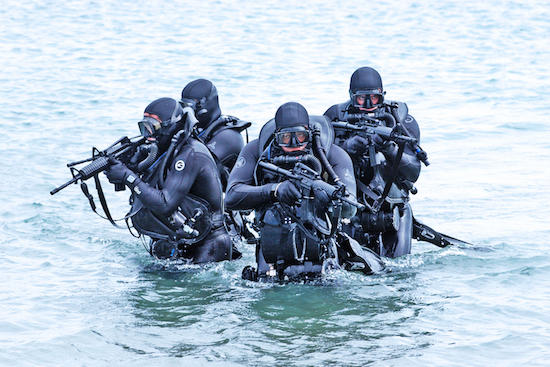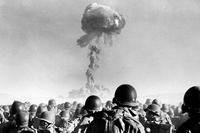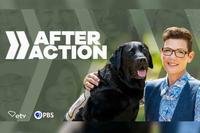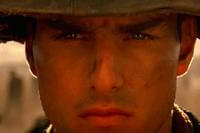
Navy SEALS - Their Untold Story, a two-hour documentary premiering tonight on PBS, tells the story of the commando units starting with their Navy Frogmen predecessors in World War II all the way up through the raid that took out Osama bin Laden.
%embed1%
Director Carol L. Fleisher gets a lot of men on camera telling stories that start with the D-Day demolition team and cover the entire pre-history of the SEALs and carry on through the Vietnam war and up through the '80s. There's as much context as can be fit into a two hour-slot. Narrated by Gary Sinise, the film gives valuable context to America's current fascination with the SEALs.

Fleisher talked to Military.com about her experiences making the film and what she hoped to accomplish in telling this story.
No one’s really done a comprehensive history of the SEALs before. What led to to choose this subject?
Well, I've done a lot of military-related films before. As a filmmaker, they are irresistible to me. There's no greater stories to tell than those of the people who do these amazing things.
I have a friend who's a Navy SEAL, Jeff Bramstedt, and we were talking about some other film projects and it came up in this conversation that no one had ever told the history of the SEALs, the true full history, going back to World War II and their forefather teams. And I was stunned. With all the publicity attendant to the SEALs these days, I just couldn’t believe this hadn't been done. There was a History Channel special, but they didn’t go into the kind of depth that we were able to with the support of Naval Special Warfare and the Department of Defense for research.
We were able to locate the last standing man from Normandy and the Naval Combat Demolition Units. There's one other guy alive. Unfortunately, he had a brain trauma and dementia. He's 97 and can't tell his own story. But Ken Reynolds, at 89, was able to talk to us. He's since past away, so we’re grateful that we were able to film him in time. He was so thrilled that finally somebody wanted to hear his story, too.

Maybe no one has made a film like this before is because SEALs never talked. There seems to be change in SEAL culture in the last four or five years.
Well, that’s a great point. And it's challenging to make a film about men who would prefer to be invisible, both in finding the footage and the storytellers. I think that because we were strictly history and because we were able to use only former or retired personnel, it made it okay. And the Navy agreed that we needed to get these stories documented.
There wasn’t even an internal, proper oral history of these guys. We're donating our transcripts to the Navy SEAL museum so that there will be a permanent record in addition to the film. If you ask the commanding officers of the SEAL teams, they would say that they would not encourage their culture to change, that there's a good reason for the secrecy. That’s why we agreed to stop in past tense.
Well, it's interesting that your program will premiere on the same day that Fox News will premiere an interview with the guy who says he took the kill shot on Osama bin Laden.
I'm rather surprised. It goes against their ethos, that’s for sure. It's supposed to be about teams and not individuals. I'm very surprised to hear it, but I suppose the guy has to make a living too, you know? But I'm very, very surprised that someone would break that particular code of the brotherhood.
%embed2%
You bring up actually a really interesting point, which is I've talked to a lot of former Navy SEALs over the last five years, and almost none of them make it to their full 20 to get their retirement pension.They say they got pulled off duty at some point and then they couldn’t ride a desk for four, five, or six years. So they leave and then they all have to figure out a way to make a living.
I couldn’t agree more. Although I think that there are now a lot of really good NGO's out there to help these guys transition into civilian life. I think there are a couple reasons in my observations, and obviously I'm an outsider, that the guys don’t make their 20.
For one thing, it's an impossible job. I mean what they're doing is very stressful and hard on family life and these guys are gone in peacetime 270 days a year. And they’ve been at war since 2001. It's wearing on them personally, physically, emotionally, psychologically. And these are among the world's combat elite and yet what do you do with a semi-used SEAL? You know? It's a fair question and I think we should do more to help these guys when they can no longer be SEALs.

I wish your film could’ve been five hours or ten hours long, because you're just sort of skipping across of the pond. It's like a greatest hits and you're not getting as deep into a lot of these stories as they might warrant. So how did you edit it down? How did you choose which stories to tell?
It was extremely challenging to make this two hours. When I first pitched it, it was ten hours. And that’s hard to do for television just in practical terms. Also, because of secrecy issues and still the national security issues, there are things we can't go deeper into.
What I hope you come away with in the two hours is a really unique lens on world history that’s particularly American, but really it’s the world history of the 20th century from World War II on through the War on Terror. We tell how these men were called into duty for particular kinds of missions and how those missions morphed with the changing threats over time.
There's only so much you can tell in two hours. That’s one of the reasons we did a companion book that’s also coming out on Veteran's Day, co-authored by Dick Couch, a former SEAL captain and bestselling New York Times author and William Doyle, also a bestselling New York Times author, co-author of American Gun with Chris Kyle, the sadly deceased sniper. I was jealous of the book because they have the luxury of more detail and more missions than we could possibly include. And yeah, it was very hard to get this down to two hours. In fact, if you want to make a pitch to any network out there, I have enough material for ten hours, so would be happy to do a follow-on.

Well, one of the most impressive things in the film is how you set up the mission to kill Osama Bin Laden. The transition there was really powerful.
Telling the Osama Bin Laden story, at this point two years later, is challenging because it has been told so often. Now we have the actual guy coming forward who apparently made that shot. I wanted to put it in the context of who the men are and how determined they were. Going from the loss of a SEAL brother into this moment of what for the SEALs had to be a terrific victory, I wanted to personalize it a bit, both going in and out of it. My job is to humanize history and I hope we did that.

One thread in the film is how much the frogmen from World War II have in common with the men who serve as SEALS today.
They do have a lot in common, and yet they couldn’t be more different from one another as brothers are. My brothers are so different and these brothers are very different. If you look at the Medal of Honor Vietnam story, two stories that we told, the only time in modern history where one Medal of Honor recipient has saved the life of another. Those guys, one is Big Mike Thornton who's a big jovial, funny, touch-wicked, naughty boy. I hope he'll forgive my saying that, but I think it's a fair description. And Mike’s a highly respected SEAL. The other guy is also highly respected SEAL, Lieutenant Tom Norris. But Tom is slender and slight and he's very soft-spoken.
What they share is their training, their brotherhood, their lifesaving and threatening experience, and sense of humor that just doesn’t end. I found that to be very common among all the SEALs. But,physically, it was surprising to see how different they are from one another and also how different their personalities are. They are very individual and very thoughtful people, I would say. They're smart. I was impressed with everyone I met. I interviewed 57 people and I guess we ended up with 14 or 15 in the finished film. Editing that down was really hard because everybody had something to offer to this tapestry.
I wanted to tell the story of the underwater demolition teams in their role with NASA. I wanted to tell a story of a SEAL who actually went into Cuba after the Cuban Missile Crisis, but it was a great story that hadn't been told. It's in the book. In two hours, it's extremely limited and I hope not superficial, but I hope it gives a tapestry view of who the men are, what the missions were, what these guys do, how they approach it, and how they have been changed by history and how they have changed history.
I spent two years making this film, must of it groveling for money. God bless USAA and Anheuser Busch for stepping up and helping us make this film. And thanks to PBS. There's no other network in American television that would have let me tell this story this way, with context and historical framework. I'm very lucky that they wanted to collaborate on this.




